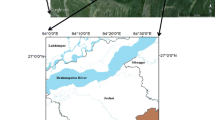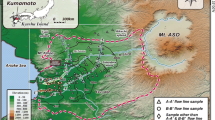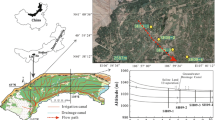Abstract
Mineral dissolution plays an essential role in controlling geogenic arsenic (As) contamination in groundwater. Although reductive dissolution of Fe oxyhydroxides is generally considered a key As release mechanism in many aquifers, some recent studies argue that silicate minerals, normally considered “inert” in As release, are the primary source of As contamination under certain conditions. The objective of this study is to determine As distribution in different minerals in a natural sediment and identify As release mechanisms and the role of silicate minerals in As release. A sediment sample was collected, characterized, and tested using leaching experiments at a range of pH and redox potentials. Our results showed that silicate minerals, which make up the bulk of the sediment, are the main As reservoir, containing 75 % of As. Fe–Mn oxyhydroxides, which are minor components in the sediment, are the second largest As reservoir and hold 16 % of As. Leaching experiments showed that silicate mineral dissolution is an important As-releasing mechanism and that high pH and low redox potential promoted silicate mineral dissolution and As release.








Similar content being viewed by others
References
Ahmed, K. M., Bhattacharya, P., Hasan, M. A., Akhter, S. H., Alam, S., Bhuyian, M., Imam, M. B., Khan, A. A., & Sracek, O. (2004). Arsenic enrichment in groundwater of the alluvial aquifers in Bangladesh: an overview. Applied Geochemistry, 19(2), 181–200.
Al-Abed, S. R., Jegadeesan, G., Purandare, J., & Allen, D. (2007). Arsenic release from iron rich mineral processing waste: influence of pH and redox potential. Chemosphere, 66(4), 775–782.
Anawar, H. M., Akai, J., & Sakugawa, H. (2004). Mobilization of arsenic from subsurface sediments by effect of bicarbonate ions in groundwater. Chemosphere, 54(6), 753–762.
Appelo, C., Van der Weiden, M., Tournassat, C., & Charlet, L. (2002). Surface complexation of ferrous iron and carbonate on ferrihydrite and the mobilization of arsenic. Environmental Science & Technology, 36(14), 3096–3103.
Basu, A., Saha, D., Saha, R., Ghosh, T., & Saha, B. (2013). A review on sources, toxicity and remediation technologies for removing arsenic from drinking water. Research on Chemical Intermediates, 1–39.
Bhattacharya, P., Chatterjee, D., & Jacks, G. (1997). Occurrence of arsenic-contaminated groundwater in alluvial aquifers from Delta Plains, Eastern India: options for safe drinking water supply. International Journal of Water Resources Development, 13(1), 79–92.
Bose, P., & Sharma, A. (2002). Role of iron in controlling speciation and mobilization of arsenic in subsurface environment. Water Research, 36(19), 4916–4926.
Breit, G., Foster, A., Sanzalone, R., Yount, J., Whitney, J., Welch, A., Islam, M., Islam, M., (2001). Arsenic cycling in eastern Bangladesh: the role of phyllosilicates. Geological Society of America Abstract with Program, pp. A192.
Casentini, B., & Pettine, M. (2010). Effects of desferrioxamine-B on the release of arsenic from volcanic rocks. Applied Geochemistry, 25(11), 1688–1698.
Chen, Y. N., Ding, L. C., & Liu, C. H. (2013). Review of the treatment of water containing arsenic. Applied Mechanics and Materials, 260, 1162–1166.
Churchill, H., Teng, H., & Hazen, R. M. (2004). Correlation of pH-dependent surface interaction forces to amino acid adsorption: implications for the origin of life. American Mineralogist, 89(7), 1048–1055.
Darland, J. E., & Inskeep, W. P. (1997). Effects of pH and phosphate competition on the transport of arsenate. Journal of Environmental Quality, 26(4), 1133–1139.
Evangelou, V. (1998). Environmental soil and water chemistry: principles and applications. New York: Wiley.
Fendorf, S., Michael, H. A., & van Geen, A. (2010). Spatial and temporal variations of groundwater arsenic in south and Southeast Asia. Science, 328(5982), 1123–1127.
Goh, K.-H., & Lim, T.-T. (2004). Geochemistry of inorganic arsenic and selenium in a tropical soil: effect of reaction time, pH, and competitive anions on arsenic and selenium adsorption. Chemosphere, 55(6), 849–859.
Grafe, M., Eick, M. J., Grossl, P. R., & Saunders, A. M. (2002). Adsorption of arsenate and arsenite on ferrihydrite in the presence and absence of dissolved organic carbon. Journal of Environmental Quality, 31(4), 1115–1123.
Gregorich, E., & Ellert, B. (1993). Light fraction and macroorganic matter in mineral soils. Soil sampling and methods of analysis (pp. 397–407). Boca Raton: Lewis Publ.
Gustafsson, J., (2009). Visual MINTEQ ver. 2.61. Department of land and water resources engineering, KTH Royal Institute of Technology, SE-100, 44.
Harvey, C. F., Swartz, C. H., Badruzzaman, A., Keon-Blute, N., Yu, W., Ali, M. A., Jay, J., Beckie, R., Niedan, V., & Brabander, D. (2002). Arsenic mobility and groundwater extraction in Bangladesh. Science, 298(5598), 1602–1606.
Kapaj, S., Peterson, H., Liber, K., & Bhattacharya, P. (2006). Human health effects from chronic arsenic poisoning—a review. Journal of Environmental Science and Health, Part A, 41(10), 2399–2428.
Kosmulski, M. (2011). The pH-dependent surface charging and points of zero charge: V. Update. Journal of Colloid and Interface Science, 353(1), 1–15.
Kostka, J. E., Haefele, E., Viehweger, R., & Stucki, J. W. (1999). Respiration and dissolution of iron (III)-containing clay minerals by bacteria. Environmental Science & Technology, 33(18), 3127–3133.
Kursun, I. (2010). Determination of flocculation and adsorption desorption characteristics of Na-feldspar concentrate in the presence of different polymers. Fizykochemiczne Problemy Mineralurgii, 44, 127–142.
Langner, H. W., & Inskeep, W. P. (2000). Microbial reduction of arsenate in the presence of ferrihydrite. Environmental Science & Technology, 34(15), 3131–3136.
Lengke, M. F., Sanpawanitchakit, C., & Tempel, R. N. (2009). The oxidation and dissolution of arsenic-bearing sulfides. The Canadian Mineralogist, 47(3), 593–613.
Lett, R. E., (1995). Analytical methods for drift. In Drift exploration in the Canadian Cordillera, British Columbia. P. T. Bobrowsky, S. J. Sibbick, J. M. Newell and P. F. Matysek (Eds.); British Columbia Ministry of Energy. Mines and Petroleum Resources: Paper 1995–2, p. 215–228.
Levson, V. M., (2001). Regional till geochemical surveys in the Canadian Cordillera: sample media, methods and anomaly evaluation. In Drift exploration in glaciated terrain, M. B. McClenaghan, P. T. Bobrowsky, G. E. M. Hall and S. J. Cook (eds.). Association of Exploration Geochemistry - Geological Society of London: Special Publication 185, 45–68.
Lin, Z., & Puls, R. (2000). Adsorption, desorption and oxidation of arsenic affected by clay minerals and aging process. Environmental Geology, 39(7), 753–759.
Lin, T. F., & Wu, J. K. (2001). Adsorption of arsenite and arsenate within activated alumina grains: equilibrium and kinetics. Water Research, 35(8), 2049–2057.
Mandal, B. K., & Suzuki, K. T. (2002). Arsenic round the world: a review. Talanta, 58(1), 201–235.
Manning, B. A., & Goldberg, S. (1997). Adsorption and stability of arsenic (III) at the clay mineral-water interface. Environmental Science & Technology, 31(7), 2005–2011.
Masuda, H., Shinoda, K., Okudaira, T., Takahashi, Y., & Noguchi, N. (2012). Chlorite—source of arsenic groundwater pollution in the Holocene aquifer of Bangladesh. Geochemical Journal, 46(5), 381.
McArthur, J., Banerjee, D., Hudson-Edwards, K., Mishra, R., Purohit, R., Ravenscroft, P., Cronin, A., Howarth, R., Chatterjee, A., & Talukder, T. (2004). Natural organic matter in sedimentary basins and its relation to arsenic in anoxic ground water: the example of West Bengal and its worldwide implications. Applied Geochemistry, 19(8), 1255–1293.
McArthur, J. M., Nath, B., Banerjee, D. M., Purohit, R., & Grassineau, N. (2011). Palaeosol control on groundwater flow and pollutant distribution: the example of arsenic. Environmental Science & Technology, 45(4), 1376–1383.
Nevalainen, R., (1989). Lithology of fine till fractions in the Kuhmo greenstone belt area, eastern Finland. Geological Survey of Finland., Special Paper 7: 59–65.
Nickson, R., McArthur, J., Burgess, W., Ahmed, K. M., Ravenscroft, P., & Rahmanñ, M. (1998). Arsenic poisoning of Bangladesh groundwater. Nature, 395(6700), 338.
Nickson, R. T., McArthur, J. M., Ravenscroft, P., Burgess, W. G., & Ahmed, K. M. (2000). Mechanism of arsenic release to groundwater, Bangladesh and West Bengal. Applied Geochemistry, 15(4), 403–413.
Nriagu, J., Bhattacharya, P., Mukherjee, A., Bundschuh, J., Zevenhoven, R., & Loeppert, R. (2007). Arsenic in soil and groundwater: an overview. Trace Metals and other Contaminants in the Environment, 9, 3–60.
Pecharsky, V., Zavalij, P., (2008). Fundamentals of powder diffraction and structural characterization of materials, 69. Springer.
Popovic, A., Djordjevic, D., & Polic, P. (2001). Trace and major element pollution originating from coal ash suspension and transport processes. Environment International, 26(4), 251–255.
Rageh, O. M., Coles, C. A., Lye, L. M., (2007). Statistical analysis of Newfoundland drinking water sources containing arsenic. OttawaGeo2007, Proc. 60th Canadian Geotechnical Conference and 8th Joint CGS/IAH-CNC Groundwater Conference, Oct. 21–24, 2007, Ottawa, Ontario, Canada.
Raven, K. P., Jain, A., & Loeppert, R. H. (1998). Arsenite and arsenate adsorption on ferrihydrite: kinetics, equilibrium, and adsorption envelopes. Environmental Science & Technology, 32(3), 344–349.
Reyes, I., & Torrent, J. (1997). Citrate-ascorbate as a highly selective extractant for poorly crystalline iron oxides. Soil Science Society of America Journal, 61(6), 1647–1654.
Sahu, S. J., Nath, B., Roy, S., Mandal, B., & Chatterjee, D. (2012). Bioavailability of arsenic in the soil horizon: a laboratory column study. Environmental Earth Sciences, 65(3), 813–821.
Seddique, A. A., Masuda, H., Mitamura, M., Shinoda, K., Yamanaka, T., Itai, T., Maruoka, T., Uesugi, K., Ahmed, K. M., & Biswas, D. K. (2008). Arsenic release from biotite into a Holocene groundwater aquifer in Bangladesh. Applied Geochemistry, 23(8), 2236–2248.
Serpa C., Batterson, M., Guzzwell, K., (2009). The influence of bedrock and mineral occurrences on arsenic concentrations in groundwater wells in the Gander Bay area, Newfoundland. Current Research. Newfoundland and Labrador Department of Natural Resources Geological Survey, Report 09–1: 315–337.
Shilts, W. (1993). Geological Survey of Canada’s contributions to understanding the composition of glacial sediments. Canadian Journal of Earth Sciences, 30(2), 333–353.
Smedley, P., & Kinniburgh, D. (2002). A review of the source, behaviour and distribution of arsenic in natural waters. Applied Geochemistry, 17(5), 517–568.
Stollenwerk, K. (2003). Geochemical processes controlling transport of arsenic in groundwater: a review of adsorption. Arsenic in Groundwater, 67–100.
Sylvester, P. J., (2012). Use of the mineral liberation analyzer (MLA) for mineralogical studies of sediments and sedimentary rocks. In Quantitative mineralogy and micro-analysis of sediments and sedimentary rocks (P. Sylvester, ed.) Mineral. Assoc. Can. Short Course Series 42: 1–16.
Tarvainen, T. (1995). The geochemical correlation between coarse and fine fractions of till in southern Finland. Journal of Geochemical Exploration, 54(3), 187–198.
Tessier, A., Campbell, P. G., & Bisson, M. (1979). Sequential extraction procedure for the speciation of particulate trace metals. Analytical Chemistry, 51(7), 844–851.
Tsai, S. L., Singh, S., & Chen, W. (2009). Arsenic metabolism by microbes in nature and the impact on arsenic remediation. Current Opinion in Biotechnology, 20(6), 659–667.
Venturini, M., & Berthon, G. (1989). Aluminum speciation studies in biological fluids. Part 2. Quantitative investigation of aluminum-citrate complexes and appraisal of their potential significance in vivo. Journal of Inorganic Biochemistry, 37(1), 69–90.
Visoottiviseth, P., Francesconi, K., & Sridokchan, W. (2002). The potential of Thai indigenous plant species for the phytoremediation of arsenic contaminated land. Environmental Pollution, 118(3), 453–461.
Wang, S., & Mulligan, C. N. (2006). Occurrence of arsenic contamination in Canada: sources, behavior and distribution. Science of the Total Environment, 366(2–3), 701–721.
Wang, S., & Mulligan, C. N. (2013). Effects of three low-molecular-weight organic acids (LMWOAs) and pH on the mobilization of arsenic and heavy metals (Cu, Pb, and Zn) from mine tailings. Environmental Geochemistry and Health, 35(1), 111–118.
Williams, L. E., Barnett, M. O., Kramer, T. A., & Melville, J. G. (2003). Adsorption and transport of arsenic (V) in experimental subsurface systems. Journal of Environmental Quality, 32(3), 841–850.
Xu, H., Allard, B., & Grimvall, A. (1991). Effects of acidification and natural organic materials on the mobility of arsenic in the environment. Water, Air, and Soil Pollution, 57(1), 269–278.
Acknowledgments
This work was supported by the Research and Development Corporation of Newfoundland and Labrador’s Ignite R&D Program (Project # 5404.1354.101). We are grateful to Dr. Stephen Amor at Newfoundland and Labrador’s Department of Natural Resources for his help in selecting sampling sites and for allowing us to use his sampling equipment.
Author information
Authors and Affiliations
Corresponding author
Electronic supplementary material
Below is the link to the electronic supplementary material.
ESM 1
(DOCX 162 kb)
Rights and permissions
About this article
Cite this article
Alam, M.S., Wu, Y. & Cheng, T. Silicate Minerals as a Source of Arsenic Contamination in Groundwater. Water Air Soil Pollut 225, 2201 (2014). https://doi.org/10.1007/s11270-014-2201-9
Received:
Accepted:
Published:
DOI: https://doi.org/10.1007/s11270-014-2201-9




